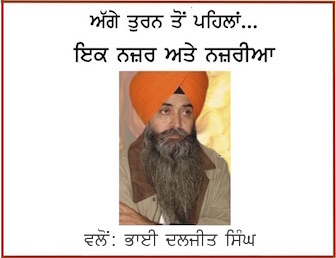Articles/Opinion
Main Naa Maanu – Indian Media on Sadda Haq issue
April 28, 2013 | By Sikh Siyasat Bureau
In a previous write up on the issue of Indian media and Sadda Haq (Fabricating a controversy), We tried to explore the highly biased approach of the Indian media towards Punjab film Sadda Haq. Reasons behind this approach were also discussed.
At that time the movie was facing tough times – when it had already been banned in five northern states of India, the main market of Punjabi films. That was the time when Indian media’s “super cop award” holder, former DGP of Punjab was demanding arrest of Sadda Haq team.
Except just few sincere sections of media, the Indian media was seen celebrating the ban imposed on the screening of the movie.
The producers of Sadda Haq tried to convince Punjab government to have talks with them. They suggested that a joint committee of representatives of various faiths and political-social-religious groups, including intellectuals could be formed to review the movie. They were even ready to cut down scenes from the movie, if found objectionable by that committee; but the Punjab government did not listen to them. No one from the media paid any weight-age to these pleas.
Then the producers of Sadda Haq moved to the Supreme court of India as a last resort. The SCI formed a committee of senior advocates to review the movie and on the recommendations of that committee lifted the ban imposed by the state governments of Punjab, Haryana, Delhi, Chandigarh and Jammu & Kashmir.
Now certain sections of media have termed the lifting of the ban as a set-back for the Punjab government. But in our opinion it’s not only a set-back for the Punjab government or the other governments that had banned the movie; accept it or not, it’s also a set-back for major sections of Indian media that had indulged themselves into motivated and biased propaganda against the movie.
Before discussing current situation in this regard, let us have a brief look at the propaganda tools put in use by media in this case.
 Fabricating the controversy: Various sections of Indian media indulged themselves into the process of fabricating a controversy surrounding the movie. This aspect was thoroughly discussed in our last write-up that how Indian media fabricated an unfounded controversy over “Baghi”, a promotional song by Jazzy B. (for details check – Fabricating a controversy – Indian Media and Sadda Haq).
Fabricating the controversy: Various sections of Indian media indulged themselves into the process of fabricating a controversy surrounding the movie. This aspect was thoroughly discussed in our last write-up that how Indian media fabricated an unfounded controversy over “Baghi”, a promotional song by Jazzy B. (for details check – Fabricating a controversy – Indian Media and Sadda Haq).
Attack with terms: Terms are powerful tools, that could put sudden impact on the minds of readers (listeners/viewers). Short terms always carry certain generalized prescriptions or ideas with them and when these terms are used in a particular context, and in a particular way, then one need not to explain the attached prescriptions to the audience, as the use of terms itself would convey it all.
Indian media attacked on Sadda Haq Punjab movie with certain specific terms in order to create generalized bias against the movie. “Movie glorifying terrorism/terrorists”, “movie glorifying militancy/extreemism”, “non-artistic” and “sectarian movie”, “Pro-Khalistan Movie” etc. are certain specific terms that were frequently put in use. It is notable that these terms were being used even before the release of the movie, which indicates that these were being used by media without actually watching the movie.
Suppressing the facts: Third major tool used by media was that it suppressed the facts by not carrying reports, or even when the reports were carried no proper context was given to them. For example it’s a known fact that high-ups in Punjab police and bureaucracy, including Punjab DGP Sumedh Saini watched the movie in Punjab Bhawan in April 04. They were instrumental in getting the last minute ban imposed on the movie. There were news reports in media that the police chief and bureaucrats watched the movie but these reports were without proper context. The reports by media gave an impression as if it was a proper committee to advise the government for imposing ban on the movie.
No one dared to report that the police chief is facing criminal trial for alleged human rights abuses. These human rights abuses were committed during a period that is covered by the Sadda Haq movie. Therefore, it was but natural for Sumedh Saini to get biased against the movie.
It is an established and internationally recognized principle of natural justice that judges should be independent and impartial. The crux of fact is that the so-called committee that pushed the government to ban the movie was not and independent and impartial entity to judge the movie. But this fact did not find any mention in the media reporting.
The producers of the movie out-cried that bureaucrats should be allowed to have final say in these matters and government should create a proper committee representing various sections of Punjabi society, as well as the administration in Punjab. The media did not gave enough weight-age to this genuine and honest suggestion.
Thirdly, the movie was screened without trouble for four days at Karnal (Haryana). It was screened without trouble on April 05 at Kurukshetra. Screenings at Hamirpur (Himachal Pardesh), Mumbai (Maharashta) and Indaur (Madhya Pradesh) remained completely peaceful and did not pose any threat to communal harmony or law and order. The state governments had taken a plea to impose ban on the movie that it could adversely affect communal harmony or law and order. The fact of peaceful screening was also not highlighted by media.
The decision of Supreme Court of India lifting ban from the movie has not brought any change in the attitude of media. Most of the media sections who were pro-active in reporting the ban on the movie, adopted a passive approach when SCI lifted the ban from the movie. It was found that most of the media sections that carried the news related to the SCI decision to lift the ban, retained their claims against the movie – such as the movie “is said to be” glorifying militant leaders, and so on.
A particular news channel, that is under direct influence/control of the ruling Badal family of Punjab, went on to repeatedly propagate that the SCI lifted the ban form the movie only after removing the “Baghi” song from it. It was clearly meant to misguide the people, because that song was never a part of the movie.
An online news portal that was instrumental in floating the idea of “controversy” over the “Baghi” still retains the claim that the Sadda Haq was “sectarian” and “non-artistic”, besides allegedly glorifying militancy. This news portal had raised questions over the authority of FCAT (Film Certification Appellate Tribunal), that had cleared the movie lifting the initial ban that was imposed by Central Board of Film Certification (CBFC), by saying that: “[i]nformed sources said that the film had been denied certificate by the Censor Board and even the review committee had found nearly half the film objectionable. Under these circumstances, how did the chairman of the FCAT, Lalit Bhasin, and another member found it fit for exhibition and issued it the certificate?”. Obviously, we agree that media should have the liberty to pose questions on the authorities, but the basic fact is that with what intentions media uses that liberty?
It is notbale that if the Supreme Court of India’s decision to lift the ban from the movie is a set-back for Punjab government because it’s allegations against the movie were imaginary or unfounded, then it must be said that it’s also a slap on the face of those sections of Indian media that had indulged themselves into a process of biased and unfounded propaganda against the movie.
But the media is still propagating against the movie as it has shamelessly adopted “main naa maanu” attitude.
To Get Sikh Siyasat News Alerts via WhatsApp:
(1) Save Our WhatsApp Number 0091-855-606-7689 to your phone contacts; and
(2) Send us Your Name via WhatsApp. Click Here to Send WhatsApp Message Now.
Sikh Siyasat is on Telegram Now. Subscribe to our Telegram Channel
Related Topics: Indian Media, Punjabi Movies, Sadda Haq





